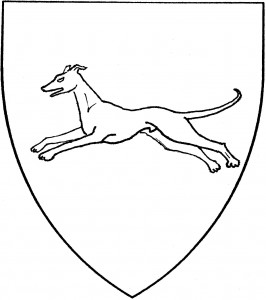The dog is a domesticated beast bred for herding, hunting, and guard duty; it was the medieval archetype of loyalty and fidelity. The most common breed of dog found in period heraldry, dating from 1285, is the floppy-eared hunting hound: this breed is variously blazoned a “kennet” (in the canting arms of Kennet c.1285 [DBA1 293]), or more famously as a “talbot” (in the canting arms of Talbot c.1450 [DBA1 202]). It might also, more simply, be blazoned a “hound”, as in the canting arms of Hondgate, temp. Henry VI [DBA2 295]. The illustration shows a talbot passant.
Another breed frequent in period heraldry is the “greyhound” or “levrier”, a fast slender breed (here shown courant). As a charge, it dates from c.1285, in the canting arms of Maleverer [ANA2 111]. (We also have a period example of the greyhound blazoned as a “gower” – i.e., a goer, a fast dog – in the canting arms of Gower, c.1460 [DBA2 295].)
Period armory also gives us the “alaunt” or “alaund”, a short-eared mastiff, in the arms of Woode c.1460 [RH]; the illustration shows an alaunt statant.
The terms “cur”, “mongrel”, &c, (and of course “dog”) may also be used, to refer to a generic dog; such terms are often chosen for the sake of a cant. In Society heraldry, while any demonstrably period breed of dog may be registered, the use of specific breeds beyond those found in period heraldry carries a step from period practice.
For related charges, see fox, hyena, wolf.
Mary of Tamar bears: Or, two levriers rampant addorsed, tails couped sable.
Otta the Terrible bears: Gules, two talbots combattant Or.
Evan Hawkins bears: Or semy of arrows gules, an alant rampant collared azure.


